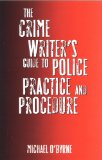Finished reading Michael O’Byrne’s The Crime Writer’s Guide to Police Practice and Procedure on the way to work today. There are plenty of books on writing crime fiction around including the Writer’ Digest Howdunit series. What makes this book stand out in the photo lineup is its focus on British policing and that being published in 2009 it is extremely up to date.
The opening chapter covers the detail of a major murder investigation including the roles of the officers who would be involved, the crime scene and the use of the HOLMES computer system. The second chapter covers the tools the police use such as stop and search, arrests, searches of premises and interviews. The remaining chapters cover forensics, profiling, other serious crime, the use of force, technology, organised crime and relationships with other agencies. A chapter of police miscellany covers discipline, suspension, senior officers, police culture, informants and representative organisations. There are useful notes in many places on using the material for writers including warnings of the pitfalls of following too closely the real world in a narrative.
Michael O’Byrne served as a Police Officer in the Royal Hong Kong Police in the 1960s. He then worked in Notting Hill, the West End, New Scotland Yard, Surrey and the Thames Valley before ending his police career as chief constable of Bedfordshire. This really helps as we get a view of the police from an officers who has served in every rank and in both city and rural forces. He is also someone who has written so he has an idea of the challenges facing a writer and what they need to know.
One problem writers can find trying to research the police is that the memoirs of real life police officers don’t include a lot of the information needed to write a story. They can shine light on police culture or specific areas of duty. They may talk about high-profile cases or dramatic incidents. By their nature they tend to be focused on one kind of crime or duty. The Crime Writer’s Guide to Police Practice and Procedure isn’t a book of reminiscences and over repeated police canteen stories. There are a few, carefully chosen ones to illustrate police culture but largely the book relies on providing information.
While it is very much a book about British policing in the 21st Century there is information that would be useful if you’re writing a story anytime back to the 1960s.
I would recommend The Crime Writer’s Guide to Police Practice and Procedure as a resource to anyone writing a police or crime story set in the UK.


Leave a Comment